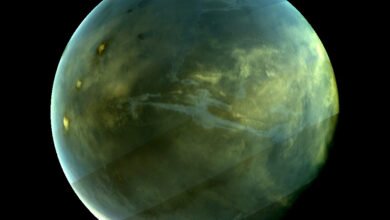Did Perseverance Find Life on Mars?

▼ Summary
– NASA’s Perseverance rover discovered an arrow-shaped rock on Mars with chemical signatures and structures that could indicate ancient microbial life.
– A new peer-reviewed paper in Nature reports that the findings are consistent with a biosignature but not definitive proof of past water-based life on Mars.
– Definitive proof might require analysis of Martian samples back on Earth, as non-biological processes could also explain the data.
– The Perseverance rover landed in Jezero Crater, chosen for its river delta-like rocks suggesting past flowing water meeting a lake.
– The rover is equipped with multiple instruments, including cameras, spectral analyzers, X-ray tools, ground-penetrating radar, weather modules, and a drill for sample collection.
The search for life beyond Earth took a compelling turn with the latest findings from NASA’s Perseverance rover, which has been exploring the ancient river delta of Jezero Crater on Mars. A detailed peer-reviewed study published in Nature presents evidence of chemical signatures and mineral structures that align with what scientists would expect from ancient microbial activity. While not conclusive proof, the data strongly suggests that Mars once hosted environments capable of supporting life.
The investigation centers on an unusual arrow-shaped rock first observed last year. Initial analysis hinted at possible biological origins, but researchers emphasized the need for rigorous review. Now, with further study complete, the scientific community agrees that the features could indeed be biosignatures, though non-biological explanations remain plausible. Definitive answers may only come when samples collected by Perseverance are returned to Earth for in-depth laboratory analysis.
According to Joel Hurowitz, an astrobiologist at Stony Brook University and co-author of the paper, the team has significantly advanced its understanding of the geological setting. “We explore both abiotic and biological pathways that could have produced the textures and mineral assemblages we’ve documented,” he noted. Hurowitz hopes the discovery will inspire new experimental and field research on Earth to clarify what conditions could generate such features.
Since its landing on February 18, 2021, Perseverance has employed a sophisticated suite of instruments to examine Jezero Crater, a location selected for its clear signs of ancient water activity. The rover is equipped with high-resolution cameras, spectrometers, an X-ray instrument, ground-penetrating radar, and a weather station. Its robotic arm includes a drill that grinds rock surfaces and collects core samples, providing invaluable material for future study.
(Source: Ars Technica)







